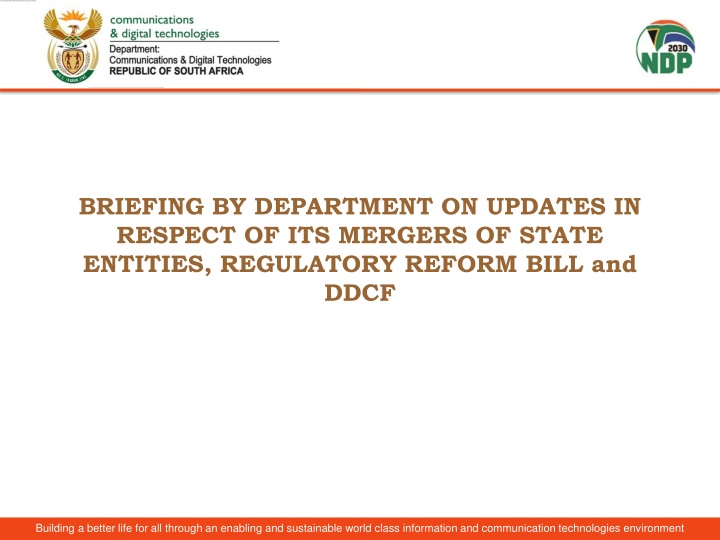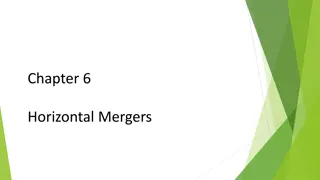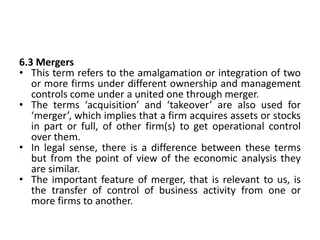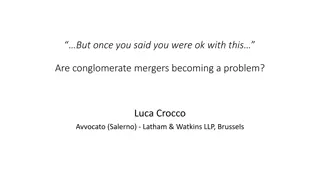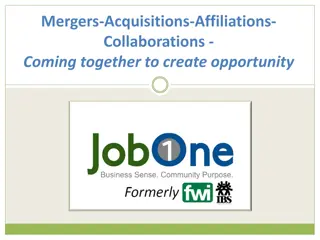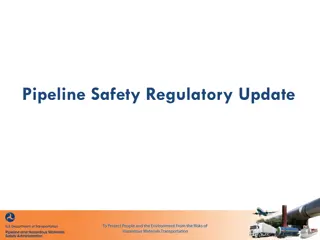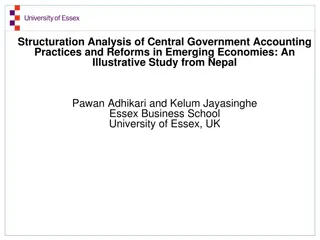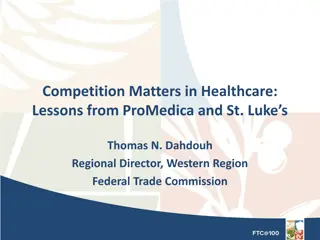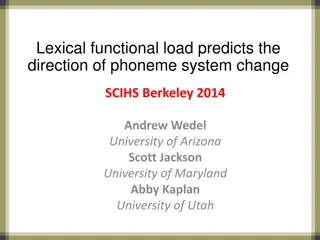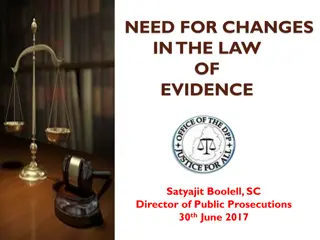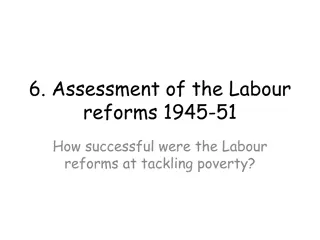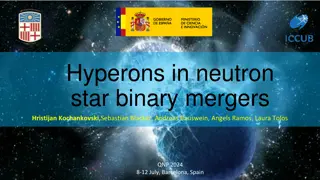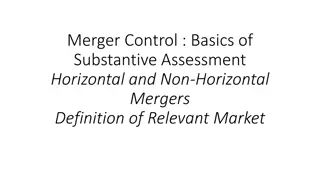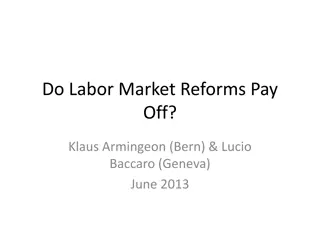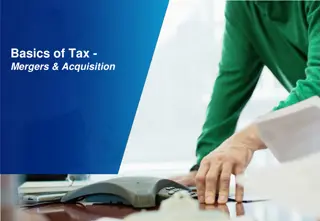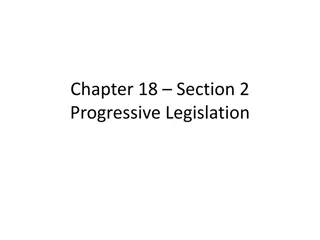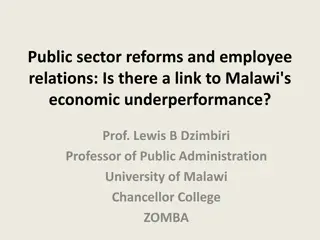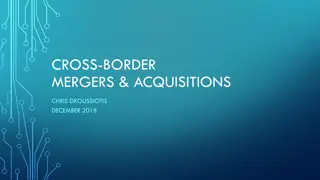Updates on Department's Mergers & Regulatory Reforms
Department highlights progress in merging state entities, development of regulatory reform bill, and initiatives for sustainable ICT environment. Focus on organizational restructuring, cost efficiency, and aligning entities for service delivery.
Download Presentation

Please find below an Image/Link to download the presentation.
The content on the website is provided AS IS for your information and personal use only. It may not be sold, licensed, or shared on other websites without obtaining consent from the author.If you encounter any issues during the download, it is possible that the publisher has removed the file from their server.
You are allowed to download the files provided on this website for personal or commercial use, subject to the condition that they are used lawfully. All files are the property of their respective owners.
The content on the website is provided AS IS for your information and personal use only. It may not be sold, licensed, or shared on other websites without obtaining consent from the author.
E N D
Presentation Transcript
BRIEFING BY DEPARTMENT ON UPDATES IN RESPECT OF ITS MERGERS OF STATE ENTITIES, REGULATORY REFORM BILL and DDCF Building a better life for all through an enabling and sustainable world class information and communication technologies environment
CONTENTS 1. SOC RATIONALISATION PROJECT 1.1 BACKGROUND 1.2 STATE DIGITAL INFRASTRUCTURE COMPANY (SDIC) UPDATE 1.3 STATE DIGITAL SERVICES COMPANY (SDSC) UPDATE 1.4 BUSINESS CASE FOR THE REGULATORY REFORM BILL 1.5 DIGITAL DEVELOPMENT CHALLENGE FUND 2 Building a better life for all through an enabling and sustainable world class information and communication technologies environment
1.1 BACKGROUND Following the establishment of the Department of Communications and Digital Technologies (DCDT) in April 2020, through the merger of the department of Communications and the Department of Telecommunications and Postal Services, the DCDT is in the process of finalising the development of a revised organisational structure. Furthermore, the DCDT is focusing on reorganising and repurposing identified State Owned Entities into resilient, self-sustaining, and effective agents for delivering services to communities. In this regard, key pieces of legislation will be prioritised including: Establishment of the State Digital Infrastructure Company (SDIC) through the merger of BBI and Sentech SOC Limited. The repurposing of SITA into a State Digital Services Company (SDSC). Regulatory Reform through the merger of the regulatory entities (ICASA, .ZadNa and FPB). Dissolution of USAASA and conversion of the USAF into a new Digital Development Challenge Fund. These reforms should aid in reducing the cost to the fiscus of administering these entities, by ensuring greater alignment of purpose and the realization of synergies among them. 3 Building a better life for all through an enabling and sustainable world class information and communication technologies environment
SDIC Policy context Alignment of SOCs at all spheres of Government in order to achieve the developmental objectives and aspirations of South Africa. The PRC calls for continued in-depth micro assessment of SOCs to assist the merging of many entities. PRC Review of the Market Structure Analysis of the benefits and cost of infrastructure duplication The need for common possibilities of structural separation of vertically integrated incumbent. NDP (ICT) carrier network, with SA Connect One of the primary objectives of SA Connect is to ensure that ICT SOC s achieve better coordination through the clear definition of roles, the integration of planning, monitoring and evaluation and the development of institutional capabilities. ICT SOC Rationalization Alignment/Rationalization of ICT SOCs in order to achieve the developmental objectives and aspirations of South Africa. Building a better life for all through an enabling and sustainable world class information and communication technologies environment 4
SDIC Technical Viability Fit 5 Building a better life for all through an enabling and sustainable world class information and communication technologies environment
SDIC Complementarity Capabilities FOR SENTECH FOR BBI Transmitter Sites Provides the base for site location Mast enhanced by access to SENTECH sites Provides the basis for high site connectivity colocation business Fibre Capacity Very little fibre in its network and significant fibre requirements to service high sites. Strong wireless capabilities which can be used for high-speed, high capacity connections particularly where fibre is not feasible in under serviced areas Synergistic sharing capabilities and with BBI Requires a detailed due diligence but conceptually, synergies should be possible in OSS and BSS systems Wireless Broadband Capabilities SENTECH s wireless capabilities can enhance broadband clients offerings to National Operating Centre Business Systems of NOC Has already developed plans for NOC-as-a-service infrastructure Sales Requires a detailed due diligence and the market focus of the two companies is somewhat different but synergies and cross-selling should be possible. 6 Building a better life for all through an enabling and sustainable world class information and communication technologies environment
1.2 SDIC UPDATE As part of the required consultations, the Department developed and submitted to the Office of the Chief State Law Advisor (OCSLA) a draft business case and bill for the merger of BBI and SENTECH in order to get a legal opinion and certification. The legal opinion necessitated the following parallel processes which the department then embarked on: Legislative Process: The Department enlisted the services the Government Technical Advisory Centre (GTAC), which assisted in enhancing the relevant policy imperatives and principles for both the SDIC business cases. As part of section 38 (1) (m) of the PFMA, the department submitted the enhanced business case to the National Treasury and the DPSA for consent. The intention is to finalize the business case by the end of first quarter (30 June 2021). The drafting of the bill will commence in the second quarter. The New Company s Act: The received legal opinion further opined that it is legally permissible to merge SENTECH and BBI invoking the provisions of section 113 of the new Companies Act as long as: The solvency and liquidity requirements of these two entities are satisfied in accordance with section 4 of the new Companies Act; In such circumstances, and where the provisions of section 113(1) are met, the proposed merger must also meet the requirements of section 113(2), requiring a written agreement to be concluded between the two entities, setting out the terms and means of effecting the merger; Building a better life for all through an enabling and sustainable world class information and communication technologies environment 7
SDIC Cont. Section 113(4) also requires that the Board of each of the merging entities consider whether upon implementation of the agreement each proposed merged company would satisfy the liquidity and solvency test; and if the Board reasonably believes that each proposed merged company would satisfy the solvency and liquidity test, it may submit the agreement for consideration at the shareholders meeting of the merging company in accordance with section 115. The shareholder conversion for BBI has been key to ensuring the BBI meets the solvency and liquidity requirements of section 113. This has since been resolved and the Minister in a position to request the Boards to start with the cooperation agreement and take the process forward. The entities are expected to start with this process by the beginning of the second quarter. The department and both the entities has also started with the enhancement of the back section of the business case which encompasses the formation of the implementation strategy and corporatisation of the new entity. 8 Building a better life for all through an enabling and sustainable world class information and communication technologies environment
SDIC Cont. Implementation Trajectory 9 Building a better life for all through an enabling and sustainable world class information and communication technologies environment
1.3 SDSC - UPDATE The State Information Technology Agency (SITA) is today standing on the cusp of a new dawn, faced with an opportunity to move with confidence into the future defined by a confluence of digital technologies which are intrinsic to the Fourth Industrial Revolution (4IR). Thus, the intention is to place SITA in a journey of evolving from traditionally focusing mainly on procurement of ICT goods, into a Digital Transformation partner for Government. Years of leadership instabilities led to the agency s inability to attract and retain leadership, management and critical skills. The average tenure of CEOs at SITA, is 1.5 years since the establishment of the agency, with the longest serving CEO lasting only 4 years, and more than 50% of senior management positions being vacant. This has brought instability to the entity, with turn-around strategies that are not fully implemented but are constantly changed creating uncertainty and lack of strategic direction. Procurement delays, irregularities and corruption led to operational inefficiencies, long procurement cycles and susceptibility to fraud and corruption combined with a lack of market intelligence to drive decisive industry transformation. As a result the Agency could not implement automated procurement solutions with built-in controls for process integrity, transparency, and business intelligence to assist decision-making and forecasting. 10 Building a better life for all through an enabling and sustainable world class information and communication technologies environment
1.3 SDSC - UPDATE SITA has experienced reputational damage through poor service delivery and corruption flowing from procurement activities. Over the years, organs of State have continued to express dissatisfaction with the services provided by SITA which has led to some organs of State requesting to be exempted from procuring ICT goods and services through SITA and in particular, network provisioning services. Having noted the above challenges, the Department developed a SOC rationalisation framework which was submitted to Cabinet in 2017. Pursuant to the approval of the SOC rationalisation framework by Cabinet for the repurposing of SITA, as with the SDIC, GTAC assisted in enhancing the relevant policy imperatives and principles for the repurposing of SITA, for the purposes of concluding the business case. 11 Building a better life for all through an enabling and sustainable world class information and communication technologies environment
1.3 SDSC - UPDATE The SDSC business case had to undergo an extensive internal consultations process and the draft has since been concluded. As with the SDIC, the intension is to have it concluded by the end of quarter 1, following the consultation with Ministries of Finance and that of the DPSA. However, it is critical to not that the creation of the SDSC is a contentious matter, particularly considering the reputational damage and the service delivery challenges as mentioned above. To mitigate this, the department intends on embarking on an extensive external stakeholder engagements. These will entail: The development of the customer survey exercise with government departments, A roadshow with key SITA clients (National and Provincial GITOCs) In conjunction with SITA, perform an analysis of the legacy systems across various government departments. This will assist in determining possible systems integration across government. 12 Building a better life for all through an enabling and sustainable world class information and communication technologies environment
1.3 SDSC - UPDATE Parallel to the legislative process, the executive team of SITA has developed a corporate strategy which also details major progress which start to respond to most of the challenges that have been identified. This can also be attested by the day to day performance of SITA against its APP targets which get monitored on a quarterly basis wherein SITA now is achieving above 80% as opposed to the previous years where it averaged around 40%. The SDSC business case finalisation is lagging behind the one for SDIC due to internal Departmental consultations that needed be concluded. The business case had to undergo an extensive internal consultations process and the draft has since been concluded. As with the SDIC, the intension is to have it concluded by the end of quarter 1, following the consultation with Ministries of Finance and that of the DPSA. However, it is critical to not that the creation of the SDSC is a contentious matter, particularly considering the reputational damage and the service delivery challenges as mentioned above. To mitigate this, the department intends on embarking on an extensive external stakeholder engagements. This will entail: The development of the customer survey exercise with government departments, A roadshow with key SITA clients (National and Provincial GITOCs) In conjunction with SITA, perform an analysis of the legacy systems across various government departments. This will assist in determining possible systems integration across government. 13 Building a better life for all through an enabling and sustainable world class information and communication technologies environment
1.3 SDSC - UPDATE Parallel to the legislative process, the executive team of SITA has developed a corporate strategy which also details major progress which start to respond to most of the challenges that have been identified: Service Category Client Complaint Mitigation Plan Long turn-around times Inefficiencies as SITA repeats Client internal approval processes Bid cancellations Volumes and Backlogs- resourcing challenges SCM reforms including hiring of people, improved processes and automation have been implemented Alignment to client approval processes to avoid process repeats. Demand and Contracting HODs recently brought on board, and other staff Enhanced Management Bid Adjudication Committee (MBAC) and Executive Bid Adjudicatication Committee (EBAC) processes and weekly sitting of the committees Procurement/ Supply Management (SCM) Chaim Uncompetitively priced internet costs- compared to open market New Internet supplier awarded to reduce costs significantly Service-oriented internet provision with commensurate port-cost reduction Aggregated demand to lower costs More agile and responsive service, with standardized service fee Internet costs Transversal contracts expired GITOC and Departments encouraged to avail resources/ people to constitute evaluation panel for Transversals Transversal contracts 14 Building a better life for all through an enabling and sustainable world class information and communication technologies environment
1.3 SDSC - UPDATE Data- lines procurement challenges New flexible and agile contracting regime finalised to offset the current piecemeal contracting regime Installation and upgrades timelines to reduce drastically Network modernisation to replace inter alia copper lines that are frequently stolen Reviewed contracting regime with 3rd parties for efficiencies Software Defined Network/ Wide Area Network investment- tender to be awarded shortly Customer Relation Managers and Line of Business directly working with the Clients to fill in and sign off the Business Take On Framework (BTOF) Process also simplified with use of technology to sniff out applications Service Delivery Network down-times Hosting Business Take on Framework complexities 15 Building a better life for all through an enabling and sustainable world class information and communication technologies environment
1.4 BUSINESS CASE FOR THE REGULATORY REFORM BILL - UPDATE The Department would want to commence development of 1st Draft regulatory reform business case (framework) by end of June 2020. Having finalised the Terms of Reference (ToRs) to appoint a service provider; the internal process of publishing the ToRs for bidding has commenced to finally appointment the service provider By end of September 2021 the intention is to finalise the 2nd Draft Regulatory Business Case developed By end of December 2021 is to finalise and develop the Draft Regulatory Business Case By the end of March 2022 the intention is to Finalise the Business Case for the Regulatory Reform Bill and submitted it to the DG for approval. 16 Building a better life for all through an enabling and sustainable world class information and communication technologies environment
1.5 DIGITAL DEVELOPMENT CHALLENGE FUND Purpose: Dissolve USAASA and convert the USAF into a new Digital Development Challenge Fund. The business case for the DDCF concluded. The Minister of Public Service and Administration and the Minister of Finance provided concurrence. SEIAS Report finalised and approved by Presidency. Electronic Communications Amendment Bill preliminary legal opinion received from the Office of the Chief State Law Adviser. FOSAD ESIEID Cluster approval obtained on 18 Feb 2021 to proceed to Cabinet, for approval to do public consultation. On 17 March 2021, the Cabinet Committee noted the progress made on the Electronic Communications Amendment Bill, 2021 as presented and directed that the Bill be strengthened in line with the discussions. 17 Building a better life for all through an enabling and sustainable world class information and communication technologies environment
Conclusion Over and above the abovementioned reforms, the department is in the process of implementing and monitoring the following turnaround strategies and amendments: Monitoring of the SABC turn-around strategy Appointing a the team of experts to develop the turnaround strategy for SAPO Facilitation of the Postbank Bill Facilitation of the SAPO amendment Bill In order to take these reforms forward, the DCDT decided to form the Joint Oversight Forum (JOF) that would be used as a vehicle to guide the process of establishing and operationalization of the business cases. 18 Building a better life for all through an enabling and sustainable world class information and communication technologies environment
Building a better life for all through an enabling and sustainable world class information and communication technologies environment 19
